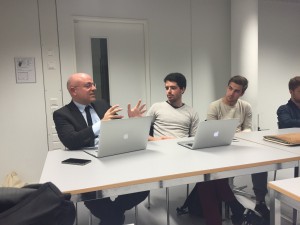The aim
This 5th semester 2 ECTS course aimed at challenging the ideas of Business Modelling and/or Innovation Management as a schedulable task for designers. In place of a droughty introduction into the commodified material on the subject of Business Model Generation [a commodified way to BMG], Design [a commodified way to Design] or Innovation Management we invited a young and open minded start-up to train our own intellectual awareness for the complexity of real world problems. To denominate this approach we name it the ‘Critical Model Vivisection’ [CMV].
The UNmethod: Critical Model Vivisection
Critical Model Vivisection [CMV] shall be the name of the advancement to reason disorderly but carefully on a ‘living’ idea, to understand and to view its internal structure and external connectedness. It motivates humans to think and to act self-assured, enlightened and limited. It shall be our deliberate reflection of a delimitated global politic, a non-polarized esthetic and a progressive artificial super-intelligence. Consequently CMV is characterized not by its universal validity but its uniqueness as a matter of numberless sequences and nervous operations. Any attempt to generalize or to commodify CMV immediately originates new operations, new sequences. As such CMV is an immaculate vivid operation to be performed ever and anon. This is the reason why we call it the unmethod.
The case: Patria Digitalis +

Patria Digitalis is a cooperative founded in June 2015, a grassroots movement of citizens campaigning for digital self-determination. Their vision is a cooperative cloud based on human-centric digital services and open technology standards. Together with FOSS (Free and Open Source Software) developers they are working on digital cloud services, enabling users to control their digital identity and assets. It was a great pleasure for us to have the chairman and co-founder of Patria Digitalis Dr. Marcos Garcia Pedraza at our seminar. Our second guest was Kaspar Etter. He developed the Digital ID Protocol and is co-founder and head of vision & technology at SYNACTS. A company developing identity management technologies, also for Intrum Justitia, a Swedish Credit Management Services company [est. 1932], employing 3,500 people and operating in over 20 countries. There was no formal contact to Intrum Justitia along our seminar, but the interaction of one of our students with Intrum Justitia unfolded an interesting setting to develop future digital services that could be provided by Patria Digitalis, in order to enforce users’ self-determination.